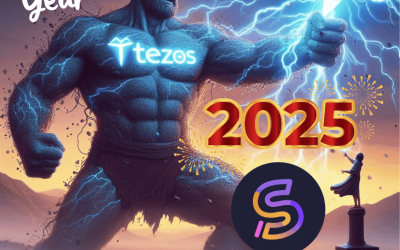Tezos VS Cardano: The ultimate comparison


Prakash P.
@Smartlink
Trust-as-a-Service for the global marketplace
The cryptoverse is a vast array of growing blockchain networks, with each promising to address the gaps left by its predecessors.
While the common trait among most of these projects is their incremental approach, there are some exceptional projects redefining the entire blockchain industry.
Tezos and Cardano lead the third generation of blockchain networks, Blockchain 3.0.
Both of these projects exhibit higher transaction throughput, better security standards, mechanisms to handle congestion, along with their fair share of architectural differences.
But, which of these platforms is better? Here is a comprehensive analysis for all those seeking Tezos vs Cardano comparison. Let’s get started.
Tezos Vs Cardano: Project History
Tezos Breakdown
What it is: Tezos is a decentralized network for applications that supports formal verification of smart contracts along with a module structure for consistent upgrades.
Ticker symbol: XTZ
Circulating supply: 877,266,529 XTZ (May 2021)
Launch date: September 2018
Consensus mechanism: Liquid Proof of Stake & Emmy+
Governance structure: On-chain governance, self-amending blockchain
Transaction throughput: 40 TPS
Current price: $3.51 (May 2021)
Tezos is the brainchild of Kathleen and Arthur Breitman, publishing the concept in September 2014. It gained popularity over its huge ICO ($232 million) and controversies surrounding its initial leadership disputes.
Cardano breakdown
What it is: Cardano is a decentralized network built for enterprise-grade applications, touted to be the only blockchain developed through a peer-review process.
Ticker symbol: ADA
Circulating supply: 31,948,309,441 ADA (Max 45 billion)
Launch date: September 2017
Consensus mechanism: Proof-Of-Stake And Ouroboros
Governance structure: On-chain governance, hard fork combinator
Transaction throughput: 7 TPS
Current price: $1.66 (May 2021)
Charles Hoskinson is the founder of Cardano. It is essential to note that Hoskinson was among the original co-founders of the Ethereum network, but he left the project over disagreements about the direction of development.
Tezos Vs Cardano: An apple-to-apple comparison

Tezos and Cardano are quite similar in terms of their consensus algorithms, using variants of PoS, and their ability to support smart contracts, but there are some major differences in how these platforms function.
Consensus Algorithm: Liquid PoS (Emmy+) Vs PoS (Ouroboros)
Tezos: Emmy+
Tezos uses a proof of stake consensus mechanism, called Emmy+.
Emmy+ adds blocks through validators, called bakers. Any participant with 8,000 ꜩ (1 roll) can become a baker in Tezos.
Bakers with a higher number of rolls have a better chance of getting selected for baking.
The selected participant must approve the transaction within a specific period of time, else the baking rights are given to the next baker.
The selected baker locks a portion of his stake through the process.
The network selects 32 random rolls to vote on the block, endorsing. As the block receives maximum endorsements, it becomes a part of the blockchain.
Tezos requires both bakers and endorsers to deposit security amounts to avoid the ‘Nothing At Stake’ problem. In the case of double endorsing or baking, the participant loses half of the security deposit.
Tezos incentivizes network participants with block rewards for their work.
Cardano: Ouroboros
Cardano also uses a variant of the proof of stake (PoS) algorithm called Ouroboros.
Ouroboros divides chains into epochs, which are further divided into slots, with each slot lasting one second.
As of now, one Cardano epoch lasts 5 days and comprises 432,000 slots.
Ouroboros protocol chooses a random slot leader for every block from staked pools. A node can expect as many as 21,600 nominations during each epoch cycle.
The slot leader verifies the transaction, ensuring that there are sufficient funds for processing the transactions along with additional parameters.
The slot leader needs to consider the last few blocks of the chain as transient, which introduces a settlement delay to prevent any adversarial attempts.
Ouroboros rewards participants for approving transactions.

Tezos Vs Cardano: Smart Contract Language
Tezos: Michelson
Michelson is the native language for writing smart contracts on Tezos blockchain.
The primary intent behind Michelson’s design, low-level stack-based, is to facilitate formal verification of smart contracts. Tezos developers can use Smartpy as the development platform for building and testing their smart contracts.
Some important features of Tezos smart contracts are:
- Tezos smart contracts are already live, which means one can create a smart contract today and execute it over the Tezos blockchain.
- Tezos smart contracts support formal verification, allowing one to cross-verify the code using mathematical functions. This makes Tezos smart contracts secure for high-value transactions. (For further reading, visit Mi-Cho-Coq)
Cardano: Plutus Core, Marlowe
Plutus Core is a low-level scripting language used in Cardano.
It runs across Cardano’s settlement layer and computation layers, and the on-chain smart contract functionalities written in Plutus compile to Plutus Core.
Marlowe is a domain-specific language used for creating financial smart contracts on Cardano. It is designed in a way that allows non-technical individuals to create and deploy smart contracts on its built-in emulator.
Cardano users can create and test smart contracts on Plutus, a purpose-built platform for developing and testing smart contracts on Cardano.
Some important features of Cardano smart contracts are:
- Cardano aims to introduce smart contracts under the Goguen update through Alonzo hard fork, which is closer to its launch.
- Cardano aims to bring smart contracts to the masses through Marlowe. The domain-specific language makes it simple to create and execute smart contracts.
Tezos Vs Cardano: New Developments
Tezos
Tezos is preparing to upgrade its consensus mechanism to Emmy* in its next protocol upgrade, Granada. Some of the prominent changes under this upgrade include:
- Emmy* will reduce the time between blocks to 30 seconds, providing faster finality for Tezos transactions.
- Tezos-indexer will have a new feature, indicating the finality of the transaction. It makes the entire confirmation process simple for Tezos users.
- Tenderbake is a BFT consensus algorithm that can provide almost instant finality to blocks. It is under the test phase but once finished, this would be a major upgrade for Tezos.
Cardano
Cardano is working towards the deployment of the core features of the Goguen era, which introduces smart contracts in the Cardano ecosystem.
This update involves the development and launch of the technical infrastructure for supporting smart contracts on Cardano, including Plutus and Plutus Core.
This update will also introduce a multi-currency ledger to Cardano, providing support for multiple cryptocurrencies and the creation of non-fungible tokens.
Cardano will feature EVM-like functionality through KEVM, facilitating the development of enterprise-grade dApps.
- Hydra is a second-layer protocol for Cardano, providing linear scaling to the blockchain. It is suitable to consider it a state channel but with native support for smart contracts. Hydra will give Cardano the ability to scale to up to a million transactions per second in the future.
Tezos Vs Cardano: Architectural Differences
Tezos and Cardano take different design approaches.
Tezos exhibits a single layer for the settlement as well as computation of transactions whereas Cardano divides this into two different layers.
The rationale behind Cardano’s design is to split the settlement part of a transaction from its computation part.
Cardano Settlement Layer is designed to register the end value or result of the transaction.
Cardano Computation Layer, on the other hand, is where transactions are processed, including smart contract execution, contract calls, and other operations.
This approach provides Cardano flexibility in comparison to other blockchain networks.
Tezos has a single layer for both computations as well as settlements. It is built with a modular design to provide the same level of flexibility without distributing operations into two layers.
Summary: Tezos Vs Cardano
Tezos and Cardano are among the leading names in the cryptoverse.
They both address some of the primary challenges of the current blockchain industry through different approaches.
While Tezos seems to be at an advanced stage, there is little knowing how these blockchains will stack up against each other in the coming years.
What are your thoughts? We’d be happy to have your take on the topic.
Share this article

Sign up for our newsletter
Popular articles
Happy New Year 2025 from the Smartlink Team!
Trust-as-a-Service for the global marketplace Summary 2024 Recap: Major Milestones Etherlink Smart Rollup & Node Tezos Etherlink Mainnet Deployments Collaboration with Nomadic Labs Navigating a Challenging Market Etherlink: A Game Changer for 2025 Looking Ahead to...
Demystifying Escrow Payment: A Comprehensive Guide
Trust-as-a-Service for the global marketplace 🔎 Key takeaways Exploring the Benefits of Escrow Services in Crypto Transactions Maximizing Flexibility with Multi-Currency Escrow Solutions Future-Proofing Financial Transactions with Smartlink Innovation FAQ -...
Etherlink x Smartlink: Bridging Blockchain Efficiency
Trust-as-a-Service for the global marketplace 🔎 Summary Blockchain Efficiency with Etherlink x Smartlink Integration Etherlink: Affordable and Speedy Transactions on Tezos Leveraging Etherlink for Reduced Fees and Decentralization Advantages Through Etherlink...







